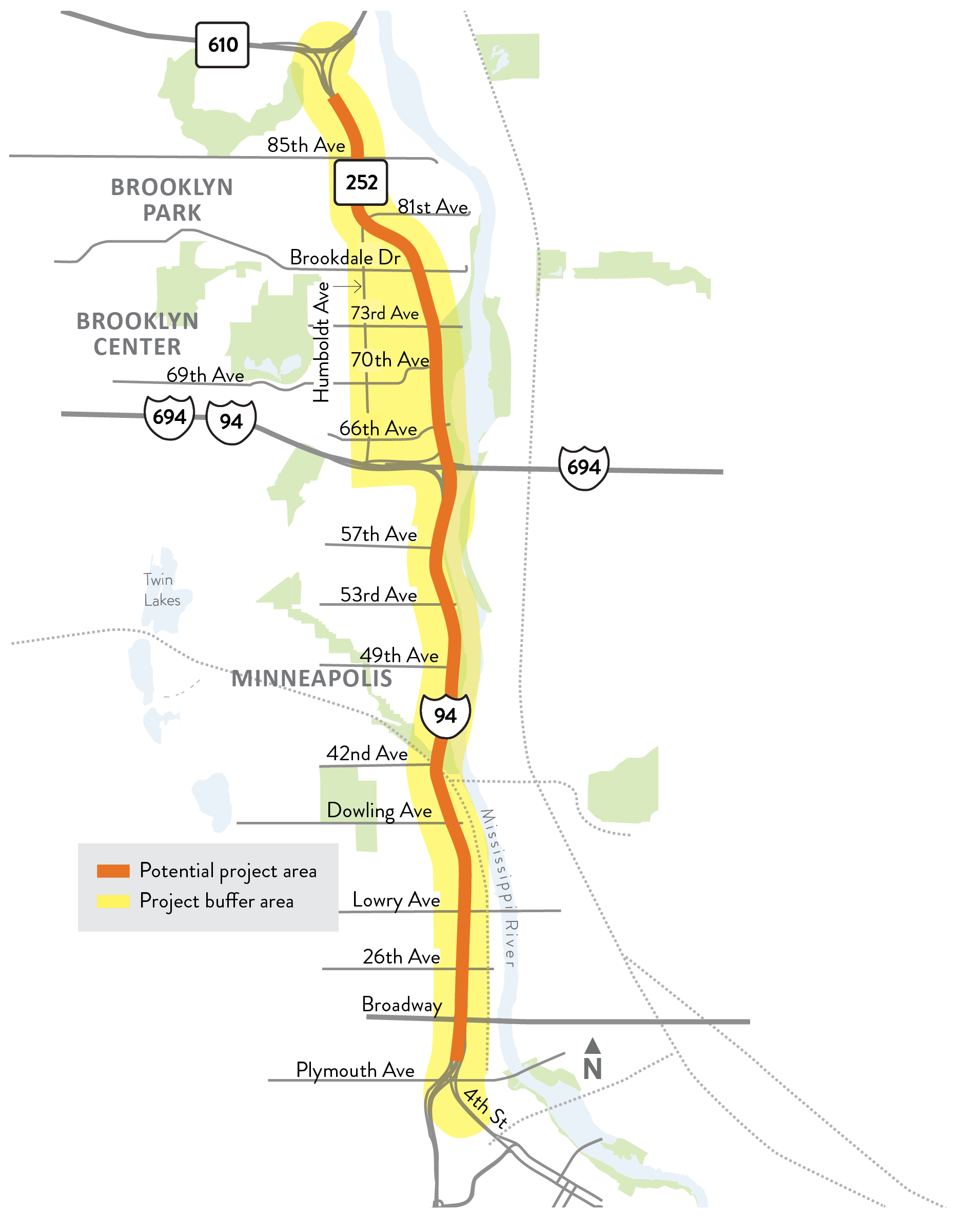What is this project's purpose and need?

Proposed project endpoints (termini) for the Hwy 252/I-94 project is Hwy 252 and Hwy 610 in Brooklyn Park to the north and I-94 and North 4th St./North 3rd St. in Minneapolis to the south. The Lowry Tunnel is located on I-94 approximately 1.5 miles south of the North 4th St./North 3rd St. entrance and exit ramps to downtown Minneapolis.
The Purpose
The purpose of the Hwy 252/I-94 Project is to improve the safe and reliable movement of people and goods across multiple modes on and across Hwy 252 and I-94 between Hwy 610 in Brooklyn Park and North 4th St. in Minneapolis.
The Need
The cities of Brooklyn Center, Brooklyn Park, and Minneapolis; Hennepin County; and MnDOT have identified several factors justifying the need for the Hwy 252/I-94 Project. The transportation needs for the Hwy 252/I-94 Project include vehicle safety, vehicle mobility, and walkability/bikeability.
Why is this project focusing on improving Hwy 252 and I-94?
Hwy 252 and I-94 need improvements for people driving, walking, biking, and taking transit.
Safety for people driving in vehicles
- The full length of Hwy 252 and I-94 within the project area have a demonstrated crash problem.
- Hwy 252 experienced a total of 1,512 crashes in 2016-2019 with an average of 378 crashes per year.
- The average annual crash cost at intersections on Hwy 252 was between $500K and $1.7M totaling $6M in 2016-2019.
- The average annual crash cost on segments along Hwy 252 was between $7M and $8M in 2016-2019.
- The total average annual crash cost on Hwy 252 was between $13M and $14M in 2016-2019.
- I-94 experienced a total of 914 crashes in 2016-2019 with an average of 229 crashes per year.
- The average annual crash cost on I-94 was between $7M and $8M totaling $30M in 2016-2019.
- Both Hwy 252 and I-94 exceed the state's critical crash rate.
Improvements for people walking and biking
- Safety and mobility for walking, rolling, and biking in the corridor is a top priority. The existing and planned pedestrian and bicycle network within the corridor is fairly extensive.
- Crossing Hwy 252 can be difficult due to number of lanes, crossing distances, and busy intersections.
- I-94 has disproportionate crossing distances and poor-quality crossings (i.e. narrow sidewalks and no ADA accommodations).
- Between 2016-2019 there were eleven reported pedestrian/bicycle crashes along I-94. No fatal crashes were reported.
Mobility for people driving in vehicles
- Hwy 252/I-94 in the project area have a mobility problem based on multiple hours of congestion, reduced vehicle speeds, increases in delays, and poor travel time reliability.
- Intersections along Hwy 252 operate poorly during peak hours.
- Segments on I-94 between I-694 and the Lowry Tunnel are congested during peak hours.
- There is a 12% increase in ridership forecasted for Hwy 252 and 4% increase for I-94.
Improvements for people using transit
- Without any transit improvements, transit ridership along Hwy 252 is expected to increase by 700 riders in total by 2040.
- According to fall 2019 data, transit ridership on express buses operating on I-94 is also expected to reach 16,300 by 2040.
- 10 percent of morning transit riders along the corridor experience off-schedule trips due to congestion.
- 20 percent of afternoon transit riders along the corridor experience off-schedule due to congestion (Fall 2019).
Connections
- Crossings influence transit riders as many must cross the highway to reach their bus stops and park and rides.
